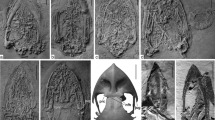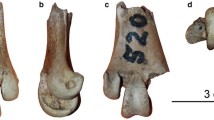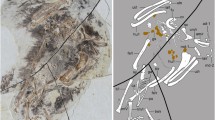Abstract
We describe the earliest fossils of the enigmatic avian taxon Opisthocomiformes (hoatzins) from the Oligo-Miocene (22–24 mya) of Brazil. The bones, a humerus, scapula and coracoid, closely resemble those of the extant hoatzin, Opisthocomus hoazin. The very similar osteology of the pectoral girdle in the new Brazilian fossil compared to the extant O. hoazin, in which it reflects peculiar feeding adaptations, may indicate that hoatzins had already evolved their highly specialized feeding behavior by the mid-Cenozoic. We further show that Namibiavis senutae from the early Miocene of Namibia is another, previously misclassified representative of Opisthocomiformes, which documents that the extant Neotropic distribution of hoatzins is relictual. Because of the weak flight capabilities of hoatzins, their occurrence on both sides of the South Atlantic is of particular biogeographic interest. We detail that this distribution pattern is best explained by dispersal from Africa to South America, and that Opisthocomiformes provide the first example of transatlantic rafting among birds.



Similar content being viewed by others
References
Agnolin F, Chimento NR (2011) Afrotherian affinities for endemic South American “ungulates”. Mamm Biol 76:101–108
Alvarenga H (1990) Flamingos Fósseis da Bacia de Taubaté, Estado de São Paulo, Brasil: Descrição de Nova espécie. An Acad Bras Ci 62:335–345
Alvarenga H (1995) Um primitivo membro da ordem Galliformes (Aves) do Terciário médio da Bacia de Taubaté, Estado de São Paulo, Brasil. An Acad Brasil Ciênc 67:33–44
Alvarenga H (1999) A fossil screamer (Anseriformes: Anhimidae) from the Middle Tertiary of Southeastern Brazil. Smiths Contrib Paleobiol 89:223–230
Billet G, Martin T (2011) No evidence for an afrotherian-like delayed dental eruption in South American notoungulates. Naturwiss 98:509–517
Böker H (1929) Flugvermögen und Kropf bei Opisthocomus cristatus und Stringops habroptilus. Morphol Jahrb 63:152–207
Carranza S, Arnold EN, Mateo JA, López-Jurado LF (2000) Long-distance colonization and radiation in gekkonid lizards, Tarentola (Reptilia: Gekkonidae), revealed by mitochondrial DNA sequences. Proc R Soc Lond B 267:637–649
Cracraft J (1971) A new family of hoatzin-like birds (Order Opisthocomiformes) from the Eocene of South America. Ibis 113:229–233
de Oliveira FB, Molina EC, Marroig G (2009) Paleogeography of the South Atlantic: a route for primates and rodents into the New World? In: Garber PA, Estrada A, Bicca-Marques JC, Heymann E, Strier KB (eds) South American primates: comparative perspectives in the study of behavior, ecology, and conservation. Springer, New York, pp 55–68
de Queiroz A (2005) The resurrection of oceanic dispersal in historical biogeography. Trends Ecol Evol 20:68–73
Domning DP (2005) Fossil Sirenia of the West Atlantic and Caribbean region. VII. Pleistocene Trichechus manatus Linnaeus, 1758. J Vertebr Paleontol 25:685–701
Ericson PGP, Anderson CL, Britton T, Elzanowski A, Johansson US, Källersjö M, Ohlson JI, Parsons TJ, Zuccon D, Mayr G (2006) Diversification of Neoaves: integration of molecular sequence data and fossils. Biol Lett 2:543–547
Gheerbrant E, Rage JC (2006) Paleobiogeography of Africa: how distinct from Gondwana and Laurasia? Palaeogeogr Palaeoclimatol Palaeoecol 241:224–246
Goloboff PA (1993) NONA, version 2.0. S.M. de Tucumán, Argentina
Grajal A, Strahl SD, Parra R, Dominguez MG, Neher A (1989) Foregut fermentation in the hoatzin, a neotropical leaf-eating bird. Science 245:1236–1238
Hackett SJ, Kimball RT, Reddy S, Bowie RCK, Braun EL, Braun MJ, Chojnowski JL, Cox WA, Han K-L, Harshman J, Huddleston CJ, Marks BD, Miglia KJ, Moore WS, Sheldon FH, Steadman DW, Witt CC, Yuri T (2008) A phylogenomic study of birds reveals their evolutionary history. Science 320:1763–1767
Hedges SB (2006) Paleogeography of the Antilles and origin of West Indian terrestrial vertebrates. Ann Missouri Bot Gard 93:231–244
Houle A (1999) The origin of platyrrhines: an evaluation of the Antarctic scenario and the floating island model. Am J Phys Anthropol 109:541–559
Hughes JM (2000) Monophyly and phylogeny of cuckoos (Aves, Cuculidae) inferred from osteological characters. Zool J Linn Soc 130:263–307
Hughes JM, Baker AJ (1999) Phylogenetic relationships of the enigmatic hoatzin (Opisthocomus hoazin) resolved using mitochondrial and nuclear gene sequences. Mol Biol Evol 16:1300–1307
Kay RF, Madden RH (1997) Mammals and rainfall: paleoecology of the middle Miocene at La Venta (Colombia, South America). J Human Evol 32:161–199
Livezey BC, Zusi RL (2007) Higher-order phylogeny of modern birds (Theropoda, Aves: Neornithes) based on comparative anatomy. II. Analysis and discussion. Zool J Linn Soc 149:1–95
Mayr G (2009) Paleogene fossil birds. Springer, Heidelberg
Mayr G, Clarke J (2003) The deep divergences of neornithine birds: a phylogenetic analysis of morphological characters. Cladistics 19:527–553
Mayr G, Manegold A, Johansson U (2003) Monophyletic groups within “higher land birds”—comparison of morphological and molecular data. J Zool Syst Evol Res 41:233–248
Miller AH (1953) A fossil hoatzin from the Miocene of Colombia. Auk 70:484–489
Milne-Edwards A (1892) Sur les oiseaux fossiles des dépôts éocènes de phosphate de chaux du Sud de la France. Compt Rend Second Congr Ornithol Internat:60–80
Mourer-Chauviré C (1983) Les Gruiformes (Aves) des Phosphorites du Quercy (France). 1. Sous-ordre Cariamae (Cariamidae et Phorusrhacidae). Systématique et biostratigraphie. Palaeovertebr 13:83–143
Mourer-Chauviré C (1999) Les relations entre les avifaunes du Tertiaire inférieur d'Europe et d'Amérique du Sud. Bull Soc Géol France 170:85–90
Mourer-Chauviré C (2000) A new species of Ameripodius (Aves: Galliformes: Quercymegapodiidae) from the Lower Miocene of France. Palaeontol 43:481–193
Mourer-Chauviré C (2003) Birds (Aves) from the Middle Miocene of Arrisdrift (Namibia). Preliminary study with description of two new genera: Amanuensis (Accipitriformes, Sagittariidae) and Namibiavis (Gruiformes, Idiornithidae). In Pickford M, Senut B (eds) Geology and palaeobiology of the Central and Southern Namib. Vol. 2: Paleontology of the Orange River Valley. Geol Survey Namibia Mem 19:103–113
Mourer-Chauviré C, Pickford M, Senut B (2011a) The first Palaeogene galliform from Africa. J Ornithol 152:617–622
Mourer-Chauviré C, Tabuce R, Mahboubi M, Adaci M, Bensalah M (2011b) A phororhacoid bird from the Eocene of Africa. Naturwiss 98:815–823
Nixon KC (2002) WinClada, version 1.00.08. Ithaca, NY: published by the author
Olson SL (1985) The fossil record of birds. In: Farner DS, King JR, Parkes KC (eds) Avian Biology, vol 8. Academic Press, New York, pp 79–238
Olson SL (1992) A new family of primitive landbirds from the Lower Eocene Green River Formation of Wyoming. In Campbell KE (ed) Papers in avian paleontology honoring Pierce Brodkorb. Nat Hist Mus Los Angeles Cty, Sci Ser 36:137–160
Poux C, Chevret P, Huchon D, de Jong WW, Douzery EJP (2006) Arrival and diversification of caviomorph rodents and platyrrhine primates in South America. Syst Biol 55:228–244
Sorenson MD, Oneal E, García-Moreno J, Mindell DP (2003) More taxa, more characters: the hoatzin problem is still unresolved. Mol Biol Evol 20:1484–1498
Stegmann B (1964) Die funktionelle Bedeutung des Schlüsselbeines bei den Vögeln. J Ornithol 105:450–463
Thomas BT (1996) Family Opisthocomidae (Hoatzin). In: del Hoyo J, Elliott A, Sargatal J (eds) Handbook of the birds of the world, vol 3. Hoatzin to Auks. Lynx Edicions, Barcelona, pp 24–32
Vidal N, Azvolinsky A, Cruaud C, Hedges SB (2008) Origin of tropical American burrowing reptiles by transatlantic rafting. Biol Lett 4:115–118
Voelker G, Rohwer S, Outlaw DC, Bowie RCK (2009) Repeated trans-Atlantic dispersal catalysed a global songbird radiation. Global Ecol Biogeogr 18:41–49
Vuilleumier F, Andors AV (1993) Avian biological relationships between Africa and South America. In: Goldblatt P (ed) Biological relationships between Africa and South America. Yale University Press, New Haven, pp 289–328
Acknowledgements
We thank B. Senut and M. Pickford for enabling study of the Namibiavis material. The photos were taken by G. Couto-Ribeiro (Hoazinavis and juvenile Opisthocomus), D. Serrette and Ph. Loubry (Namibiavis), and S. Tränkner (adult Opisthocomus). The manuscript benefited from comments of four anonymous referees. The English was improved by corrections from T. Worthy. R. Blakey is acknowledged for permission to reproduce one of his palaeomap reconstructions.
Author information
Authors and Affiliations
Corresponding author
Additional information
Communicated by: Sven Thatje
Electronic supplementary material
Below is the link to the electronic supplementary material.
ESM 1
(DOC 41 kb)
Rights and permissions
About this article
Cite this article
Mayr, G., Alvarenga, H. & Mourer-Chauviré, C. Out of Africa: Fossils shed light on the origin of the hoatzin, an iconic Neotropic bird. Naturwissenschaften 98, 961 (2011). https://doi.org/10.1007/s00114-011-0849-1
Received:
Revised:
Accepted:
Published:
DOI: https://doi.org/10.1007/s00114-011-0849-1




